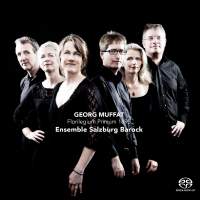Texte paru dans: / Appeared in: |
|
| "Well recommended." |
Outil de traduction ~ (Très approximatif) |
|
Reviewer: Bertil
van Boer Georg Muffat (1653–1704) is one of those figures that seems to be overlooked in music history at the turn of the 18th century. Born in Alsace, he received his training in France before obtaining a position as organist in his homeland. After several years as a professional, he moved further east to become a musician in various Habsburg households, and finally in 1678 he grabbed an appointment as cathedral organist for the Prince-Archbishop of Salzburg. Because his music was mostly in the French style and Salzburg was highly Italianate, he was sent off to Rome, where he learned to compose in that style under Bernardo Pasquini and Archangelo Corelli. One can’t get a better pedigree than that, but he apparently wasn’t able to play the political game back home in Salzburg, and when he was denied the post of Vice- Kapellmeister, he apparently left in a huff and tried to reattach himself to the Habsburg family. He finally succeeded a decade or so before his death in the provincial court at Passau. Muffat was a prolific composer who felt that his music ought to be published in various compendia. These are various instrumental pieces, such as the Armonico tributo (1682) and the 1690 Apparatus Musico-Organisticus. The first of two books of suites for strings, the Florilegium Primum follows a half decade later and is unusual in that the preface, while overly lauding his new employer the Prince-Archbishop of Passau, vented his spleen against his former leaders and compatriots in Salzburg. The vitriol is quite pointed, but despite this, he apparently flourished in Passau with his family, and his son Gottlieb was trained well enough to become a scholar under the redoubtable Johann Joseph Fux, beginning a career as a successful composer as well. This set of characteristic suites has been recorded before, in 2011 with the Ars Antiqua Austria on Pan Classics and portions two years later with Adrian Shepherd’s Cantilena on Chandos. Both recordings are perfectly acceptable. Here, however, we have the first version based upon a new publication of the Florilegium that came out only last year, and so this is a critical edition of considerable musicological research at its foundation. The seven suites or “Fasciculi” are laid out according to standard Baroque format, with alternating fast and slow dances. The French elements are evident in the opening overtures for each, while many conclude with a minuet. Only Suite IV finishes with a chaconne, Suite V a bourée (though the minuets immediately precede it), and Suit VII with a more commonplace gigue. Each of the suites is given a title, each representing a plant or set of flowers to be combined in total into the “florilegium” or bouquet. But movements also have subtitles of a pithier nature; for example, the “Entrée des Insultes,” which should be self-explanatory. The suite titles, on the other hand, reflect the dedication to his new patron, with the first a gloss on the wife of Constantine the Great, Eusebia, followed by “Sperantis gaudia” or the expectation of happiness. “Gratitudo” comes next, along with “Impatientia” and “Sollicitudo,” probably all having to do with his need to leave Salzburg and the promises for employment by his new patron. “Blanditiæ” (Indulgence) and “Constantia” (or Permanence) round out the set, with his new post being permanent and Muffat having a job of indulging his patron. There are symbolic aspects, of course, though these don’t necessarily involve the musical content itself. The music is easy to listen to, and while one may find little connection with the titles, Muffat’s ability to create works that are full bodied and nicely formulated is apparent in all of these suites. For example, the “Canaries” of “Impatientia” is rollicking and quick stepping, while the short gigue that follows is little more than a short interlude. The Sarabande is languid, while the final chaconne flows gently along. Each of the Floregium suites is created in equally a flowing and integrated fashion, with one movement, generally short, moving smoothly and succinctly into the next. The performance by the Salzburg Barock is nicely textured, with the ensemble blending well. The sound quality is even, and the instrumentalists play so well in tune that the lack of even a hint of vibrato is not noticed. Indeed, the sometimes close dissonances sound almost vocal in quality, thus enhancing the integration of the harmony of these works. This is a fine recording and one that should demonstrate that Muffat, for whatever concerns he had in his employment history, was a top-class composer and one of the major figures in the development of the Baroque suite. Well recommended. | |
|
|
|
|
Cliquez l'un ou l'autre
bouton pour découvrir bien d'autres critiques de CD |
|




